Stack height is an important factor that will affect how your running shoe feels. It refers to the amount of cushioning material that separates your foot from the ground.
But what is the ideal stack height and why does it matter? And what really is the different between shoes with high stack height versus those with low stack height?
It can be quite confusing to understand since many people confuse it with heel to toe drop and use those terms interchangeably. But don’t worry, this article will explain everything there is to it so that you can make an informed choice when choosing the right running shoes for you.
Read on to learn exactly what stack height is and why it matters to you as a runner.
What is Stack Height?
When it comes to running shoes, one of the most important factors to consider is the stack height. Stack height refers to the amount of cushioning material that separates your foot from the ground. It’s an important element in determining the degree of shock absorption and foot protection that the shoe offers to the runner.
This used to be referred to as a maximal shoe (HOKA) or a minimal shoe (Altra).
The stack height is determined by measuring the total height of the midsole, including the foam, air chambers, and other cushioning materials, from the ground to the insole’s surface.
The higher the stack height, the more cushioning and greater shock impact absorption the shoe provides. In contrast, a lower stack height means less cushioning and a more direct ground feel.
When choosing a running shoe, it’s important to consider your individual needs and preferences. Some runners prefer a higher stack height for added cushioning and protection, while others prefer a lower stack height for a more natural feel and improved stability.
It’s also worth noting that stack height can vary between different types of running shoes. For example, a maximalist shoe designed for long-distance running may have a higher stack height than a minimalist shoe designed for speed and agility.
How to Measure Stack Height in Running Shoes
Measuring stack height is an important aspect of understanding the performance and comfort of your running shoes. It can help you determine whether a shoe is suitable for your running style, as well as provide insight into the shoe’s durability and support.
To measure stack height, you can follow these simple steps:
- Remove the insole of the shoe to expose the midsole.
- Use a ruler or a tape measure to measure the distance between the ground level and the midsole’s highest point. This measurement represents the stack height.
It’s important to note that stack height can differ between the heel and the forefoot of the shoe. In some shoes, the heel’s stack height is greater than the forefoot, resulting in a positive heel-to-toe drop. This design can be handy for runners who require extra cushioning in the heel to absorb shock and reduce impact on the joints.
In some shoes, the stack height is the same throughout resulting in a zero heel-to-toe drop. These types of shoes are known as zero-drop running shoes since the stack height is equal to the forefoot stack height. In all other shoes, the heel is usually higher than the forefoot.
This design can be beneficial for runners who prefer a more natural and minimalist running experience, as it promotes a more natural foot strike and encourages the use of the foot’s natural shock-absorbing mechanisms.
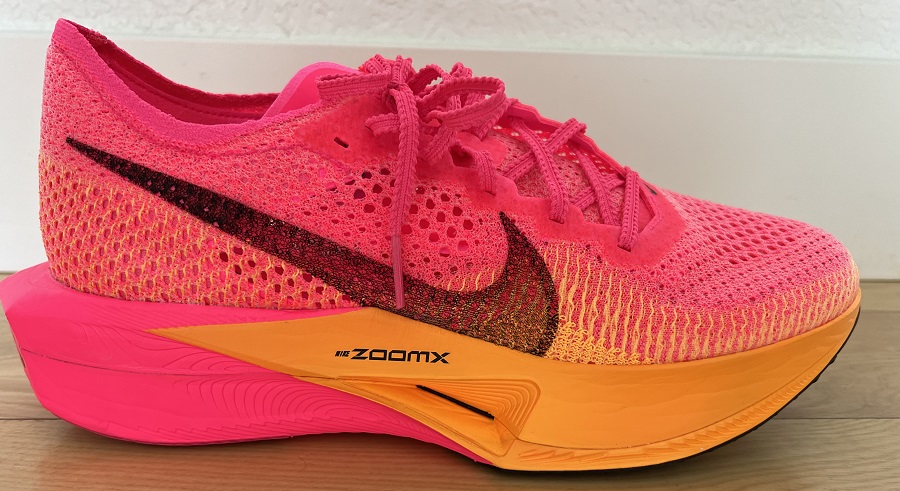
Stack Height vs Heel Drop
When it comes to choosing the right running shoe, stack height and heel drop are two essential factors that runners consider. However, it’s easy to confuse the two, and many people tend to use the terms interchangeably.
Heel drop, offset, or heel-toe drop refers to the difference in height between the heel and forefoot of a shoe. It is measured from the insole’s surface and is typically expressed in millimetres.
A higher heel drop means that the heel is elevated more than the forefoot, while a lower heel drop means that the heel is closer to the ground.
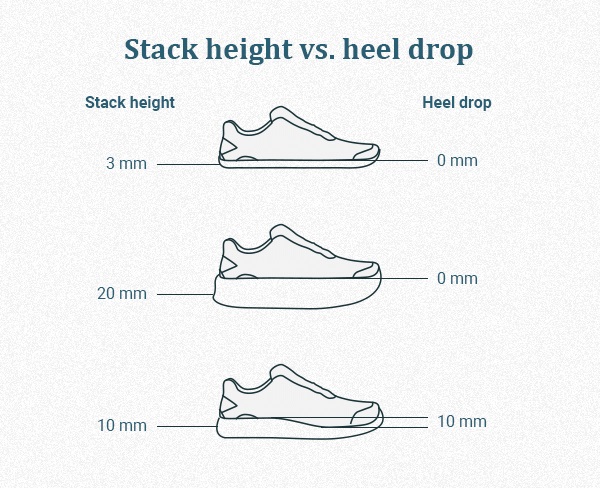
On the other hand, stack height is measured from the ground to the insole’s surface and is the total thickness of the midsole. It includes the heel and forefoot, and it’s usually expressed in millimeters as well.
A higher stack height means that there is more cushioning and protection between your foot and the ground, while a lower stack height offers a more minimalistic feel.
How Stack Height and Heel Drop Affect Runner’s Gait
While these two factors are related, they have different effects on a runner’s gait, in theory. The reality is that a great deal of it comes down to your stride and how you run. Some people will benefit from the cushion of a high stack height and others will simply overstride more as it masks what they are doing.
A higher heel drop can result in a more significant heel strike and a longer stride. It can also put more pressure on the knees and joints, which can lead to injuries over time.
In contrast, a lower heel drop encourages a midfoot or forefoot strike and a shorter stride. This can help reduce the impact on your joints and improve your running efficiency. Again..maybe…maybe not. I run in a variety of heel drops for testing and it doesn’t drastically change how my foot lands because I’ve worked on landing under my body.)
The stack height of a shoe also plays a crucial role in determining how it feels when you run. A higher stack height provides more cushioning and protection, which can be beneficial for runners who need extra support or have a history of injuries. However, it can also make the shoe feel bulky and less responsive.
A lower stack height, on the other hand, offers a more direct ground feel, which can be ideal for runners who prefer a minimalist shoe and want to feel more connected to the ground.
Stack Height and Ground Feel
The ground feel is an important factor for runners to consider when choosing their running shoes. It can greatly affect the overall running experience and performance.
A higher stack height can reduce the ground feel and provide more cushioning, which can be beneficial for runners who are looking for a more comfortable and forgiving ride.
The additional cushioning can help absorb impact forces and reduce the risk of injury, especially for those who frequently run on hard surfaces such as concrete or asphalt.
On the other hand, some runners prefer a lower stack height, as it provides a more natural gait and responsive feel. When the foot is closer to the ground, it can better sense the terrain and adjust accordingly.
This can help improve balance, stability, and agility, which can be especially important for trail runners who need to navigate uneven and unpredictable terrain.
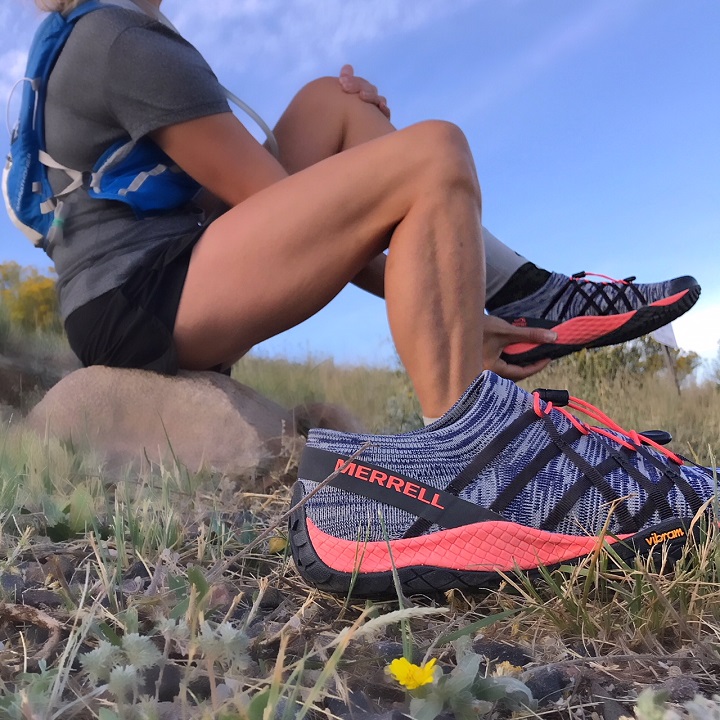
It’s worth noting that the stack height isn’t the only factor that affects the ground feel. The type and density of the midsole foam, as well as the outsole design, can also play a role.
For example, a shoe with a thick midsole but a firm outsole may still provide a relatively low ground feel, while a shoe with a thin midsole but a soft outsole may still provide a relatively high ground feel.
Stack Height Categories
Based on stack height, here are some main categories of running shoes:
Barefoot: These have the lowest possible stack height at 1 – 8mm. They’re best for limited use for speed work or strides, or running on soft surfaces like even grass.
Minimal: These have a stack height of 9 – 13mm and are usually used for faster training or if you’re looking for a minimalist running experience.
Low: These have a stack height of 14 – 18mm. They’re good for faster pace workouts or for shorter but faster races.
Medium: These have a stack height of 19 – 23mm. They’re a great type to use for most runners regardless of experience.
High: These have a stack height of 24 – 29mm and are great for longer runs or if you’re looking for a cushioned ride.
Maximal: These have a stack height of more than 30mm. They’re best for long runs and are also a great option for easy runs or recovery runs. This is also what you will find in more and more carbon fiber super shoes, as they are trying to maximize cushion.
Pros and Cons of Running Shoes with Different Stack Heights
There are different pros and cons to running shoes with varying stack heights. So let’s look at the same advantages and disadvantages of high and low stack height shoes to help you figure out which one will be best for your personal preferences:
High Stack Height
Pros:
- Greater cushioning and shock absorption
- Reduced risk of injuries caused by impact and repetitive strain
- Reduced stride length and quicker cadence
- Improved comfort for runners with heavier builds
Cons:
- Less ground feel and reduced sense of connectedness with the running surface
- Reduced stability due to a higher center of gravity, leading to trips and falls
- Higher energy expenditure due to increased weight and shoe stiffness
- May lead to leg stiffness and it can amplify impact loading
- Potential for slower times due to greater shoe resistance against the running surface
Low Stack Heights
Pros:
- Improved ground feel and increased sense of connectedness with the running surface
- Improved stability due to a lower center of gravity, leading to fewer trips and falls
- Reduced energy expenditure due to lower weight and shoe flexibility
- Potential for faster times due to less shoe resistance against the running surface
Cons:
- Less cushioning and shock absorption
- Increased risk of injuries caused by insufficient impact protection
- May not be suitable for runners with heavier builds or those with a tendency for heel striking
- May cause discomfort and pain in the feet and joints due to the diminished cushioning
How to Choose the Right Running Shoe Stack Height for You
Choosing the right running shoe stack height requires consideration of several factors, including your weight, foot strike, and running style. Plus, consider the terrain you run on, the distances you cover, and your personal preferences. Let’s look at each of these factors in more detail:
Bodyweight
When considering the ideal stack height for a runner, their weight is an important factor. Generally, heavier runners require more cushioning and a higher stack height than lighter runners. This is because the added weight creates a greater impact force on the feet, making more cushioning necessary to absorb it effectively.
Lightweight runners, on the other hand, require less cushioning and a lower stack height as their weight puts less strain on their feet. Runners should, therefore, consider their weight when selecting the right stack height for their shoes.
Running Style
Another important factor to consider when selecting the right stack height for running shoes is running style. Different running styles put different amounts of pressure on the feet and require different levels of cushioning.
For example, runners who tend to land on their heel should opt for a higher stack height with more cushioning, while runners who land on their forefoot can benefit from a lower stack height with less cushioning.
Type of Run
Another factor to consider when selecting the right stack height is the type of running you will be doing.
Long-distance runners may require more cushioning and a higher stack height than sprinters or trail runners. This is because long-distance runners are on their feet for longer periods of time and require more support and cushioning to prevent injury and fatigue.
Lower stack height is handier for less bulky shoes that will allow you to run faster, like for interval or tempo runs.
Running Surface
The type of surface you plan to run on can also affect the stack height that’s ideal for you. For example, runners who frequently run on concrete or other hard surfaces may benefit from a higher stack height to provide additional cushioning and protection against impact forces.
On the other hand, runners who primarily run on softer surfaces, such as grass or dirt trails, may not require as much cushioning and may prefer a lower stack height for better ground feel and stability.
Foot Strike
If a runner predominantly uses a heel strike, choosing the right stack height can prevent injuries and improve performance. A higher stack height can effectively absorb the shock generated by a heel strikers, reducing the risk of injuries such as shin splints, plantar fasciitis, and stress fractures.
Looking for more shoe reviews?
- Best HOKA running shoes
- Best ALTRA running shoes
- Nike vs Adidas running shoes
- Best wide toe box running shoes
Other ways to connect with Amanda
Instagram: RunToTheFinish
Facebook: RunToTheFinish
Get new posts via BlogLovin
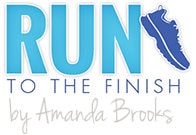
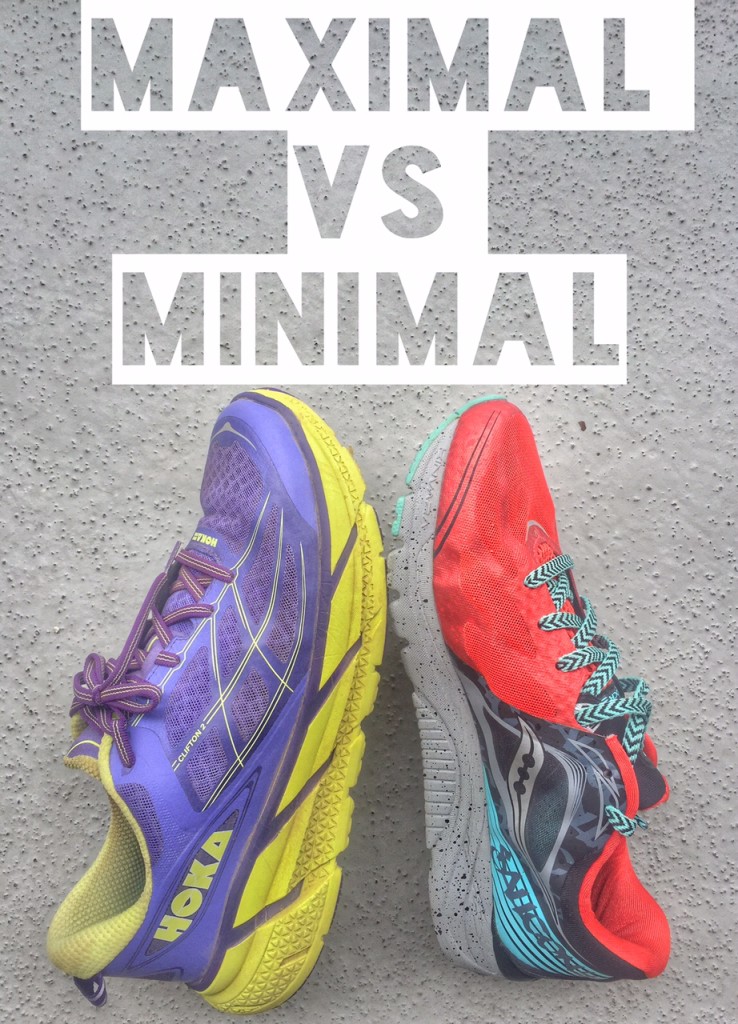
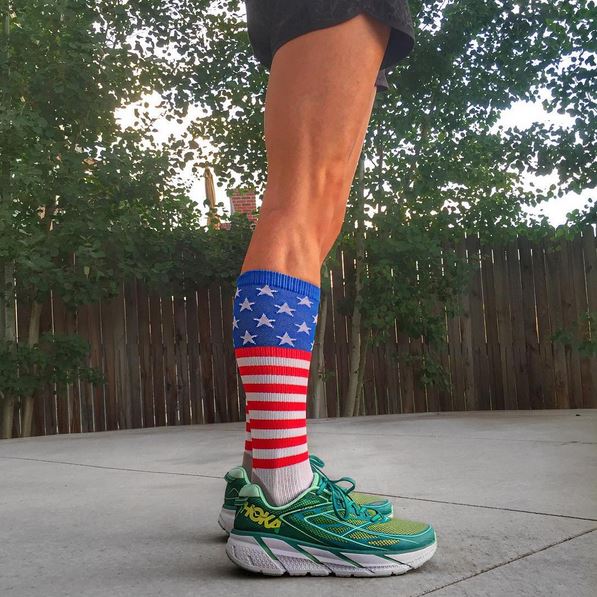

 10 Best Ankle Strengthening Exercises for Runners (A Visual Guide)
10 Best Ankle Strengthening Exercises for Runners (A Visual Guide)

Michelle
I used to run in stability Nike Pegasus, but after struggling, injury ridden through my first marathon, I switched to the then brand new Newtons. Researched, taught myself how to run in them and it was a match made in heaven! I've been faster and injury free ever since. Newtons just work well with my biomechanics, but they obviously aren't for everyone! Great post!
My recent post Weekend Recap: 1st Birthday Vineyard Snapshots + More Hills
RunToTheFinish
that's awesome! I haven't tried them yet, but have heard from a lot of people who loved them!
Darlene Cardillo
I struggle with this. I have tried them all. Right now, I train and do long runs in Hokas for support but I find them too clunky for 5k races so I wear Mizuno Wave Riders.
RunToTheFinish
I was rotating through a ton of brands, until I could finally feel a difference in my legs!
Beth
Having worked at a running store, I am all about trying new shoes. Every year when the running shoe companies tweak each model, those tweaks could make the shoe not work as well for you. My feet have also started to pronate more over time (thanks, arch collapse!), so I had to move from a neutral shoe over to a light stability shoe. I'd definitely suggest trying out different shoes, even if it's just in the store, every so often just to make sure that there isn't a shoe that's better/more comfortable for your feet!
My recent post Best Tips for Preventing Running Injuries
RunToTheFinish
YESSS the tweaks. I know they are supposed to be better, but sometimes they make the shoe totally unwearable for me….I\’m not ashamed to say I stock up on shoes I love.
morganwieboldt
THis is so informative, thank you! I get so confused and overwhelmed when trying to find shoes, but this could definitely help!!
Kathy McElhaney
I have a small foot (women's size 5) so my biggest problem is finding a shoe that actually fits. Many brands start at size 6, which is just too big. I've tried Saucony, New Balance, Asics, Mizuno and always come back to Saucony. I've tried lots of different models, but for me the brand works.
RunToTheFinish
That's so funny, my best friend in high school was like you where I was the size 11 and at that time they just hardly many any women's shoes that big!!
Rob@FitnessDrum
interesting debate – I've struggling with injuries and always relied on inner soles helping me out. But I would probably prefer the Hoka
My recent post Recipe Hacks – Chia Greek Yoghurt for a quick and easy protein boost.
RunToTheFinish
I was trying to make things work with insoles and was surprised to see how much better my knee felt when I was willing to just try a new shoe. #stubborn
Lauren @ mostlyirun
I have so many shoes in rotation! I read tons of reviews and make mental notes of the ones I want to try … and then snap them up when I see an online sale. Or when buying from my local retailers, I'll try on nearly every pair, buy the one I like best, but keep the 2nd choice in that mental list. I'm like Cinderella, waiting for the perfect shoe. Many come close, but I always have to wonder if there's something better!
My recent post review: BrightLife Go for all your compression-sock needs
johnteske88
Hi, I'm new to your blog, but I really have enjoyed what I've read so far! I'm glad I came across this post, I've been using Saucony Grid Rides for years, but have tried some minimal varieties too. The Hokas intrigued me, but I always thought they looked so unnatural and bulky, so I very much appreciated your info about them.
My recent post My Mindful Running Experiment
RunToTheFinish
Thanks John!! I admit I was totally against them when they first came out because I was in a minimal shoe! But a friend asked me to give them a try and with knee pain at the time I was open to trying anything. Totally shocked me that they felt different than imagined.
thisrunnersrecipes
I wear minimalist shoes, but what really makes a difference for me is the low drop, which both types have. The Brooks Pure line works well for me. I used to run in super minimal Merrell Bare Access shoes, but those left my feet aching once I started running longer distances.
My recent post Stability Ball Core Workout
Susan
Great post. I am a natural fore foot striker and feel good w/ my Saucony Guide (I have worn the Guides forever). I did recently take out the orthotics I wore since 2009 (I never knew they are only supposed to be a temp fix unless you have no arch and pronate). I was scared to take them out and noticed I was a little more sore after the first couple of runs, but now so far so good. What I struggle with is when to replace my shoes. Some people get so many miles out of them. My current pair is just over 200 and I feel like I am ready for a fresh pair!
LeeAnn
Hi Amanda. I just wanted to point out that I think the Saucony Kinvara is a 4mm drop shoe, not a zero drop. Also, I'd be interested to hear how you think the Clifton compares to the Clifton 2, and if you have tried any other Hoka models. Thanks!
RunToTheFinish
Oh my gosh, DUH!! I totally knew that, I must have been caught up in getting this done. Thank you!!
And yes here is my review of the two models: https://www.runtothefinish.com/2015/06/hoka-one-on…
Kate
I went to a shoe clinic store and had myself tested and fitted. They put me in Brooks Adrenaline and I'm now on my second pair. I get the impression they are quite high on the scale of shoe support?
They seem to be okay so I guess no need to change?
Would love your view on when to change shoes. I have just the one pair and have run about 500km in them in six months. I've read various opininons on what mileage you should get out of them.
My recent post 2 weeks to go!!
RunToTheFinish
Mileage can vary by runner, but 500miles is generally about right. Most runners start to notice a lot of fatigue in their legs or little things starting to hurt and that\’s a sign it\’s time for new shoes. As they break down they can alter your gait or the absorption is gone and that\’s the issues we feel.
Kelly Caiazzo
I switched to minimal shoes after reading Born to Run, but didn't do a good job of easing myself into them. I never got injured (luckily) but when I decided to get a more moderate pair when my Nike Free 3.0's were worn out, I really enjoyed the extra cushioning. I now run in Brooks Pure Cadence and love that they're a bit in between. My very first pair of running shoes were a pair of heavily cushioned Asics, and I can never go back to them after running in lighter shoes – they felt so HEAVY when I was running.
My recent post Have you seen College Humor’s hilarious video about running?
Nicole
as a weak-ankled person, stability sneakers all the way
Carla
I was five finger for ALL THE THINGS for close to a decade.
EVERYTHING.
now Im never seen with out my HOKAS :-)
My recent post You shouldnt bowl fruit.
Amanda S
I’ve been running in Kinvaras for years and just added the Sketchers gorun4 to the mix for the road. When I moved to CO, I got a pair of Brooks PureGrit. They’re great, but the long mountain runs with lots of rocks are starting to wear on me. I ordered a pair of Hoka Challenger ATRs based on some demos. Here’s to hoping they work!